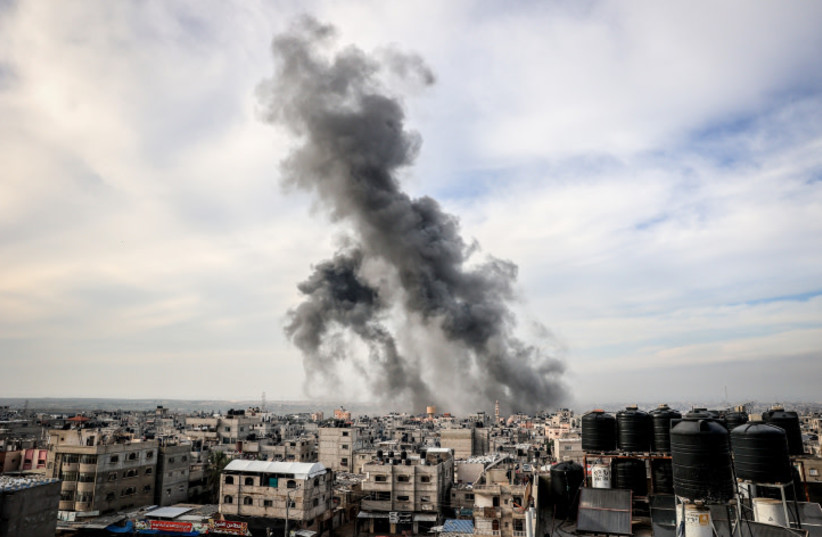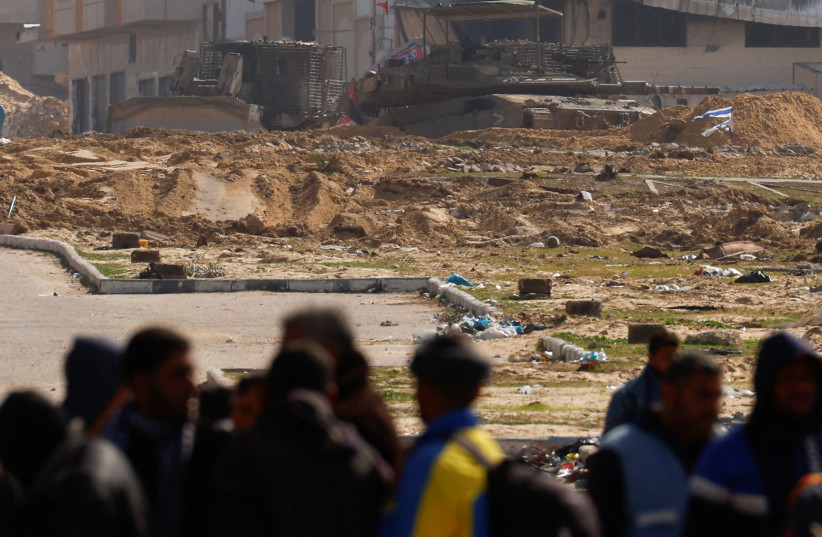How will IDF’s invasion of Rafah play out – and what will Hamas do?
If the IDF finally, in fact, invades Rafah in the coming days or weeks, the plans have been prepared for a while, and the hold-up has been at the diplomatic level with Egypt and the West.
Even back in December, the IDF strongly believed that it could handle the daunting task of evacuating and moving out of the way the 1.4 million Palestinians who had moved to Rafah, which means its current population is about six times larger than pre-war.
What is daunting about this task is that Cairo is terrified that the IDF’s invasion will lead Palestinians to penetrate their border and cross into Egypt, the US and the West are terrified that many Palestinian civilians will die (privately, Egypt could not care less about this), and that many of these people have already been moved three times: from northern Gaza to Khan Yunis to Rafah.
Will some of them just refuse to move, believing that it is no longer safe to move or that there is no end to their explosions if they do not, at some point, draw a line and stay?
Will some of Egypt’s or the West’s worst nightmares transpire, leading to a crisis and mid-invasion halt?

Rafah does not just have around six times its normal population right now, its around 65 square kilometers is only around one six of Gaza’s 365 square kilometers.
This means that this is the densest evacuation the IDF will have managed, even compared to the greater Gaza City area, which at some point had around 1.2 million people, but which was a significantly larger area.
In order to start answering these questions, the key real first question is where does the IDf plan to move the civilian population?
There are three main options: Al-Mawasi in the northeast, which already has some hundreds of thousands; back to Khan Yunis in the north and northwest, where some of them just left; and further north to central Gaza.
Al-Mawasi might be the best option, but it probably cannot hold all the evacuees it already has, plus all of those from Rafah, though it is expected to take many.
Khan Yunis is as close as al-Mawasi but has the drawback of being the least stable area in that the IDF has only achieved operational control in the last week.
Reinjecting a large civilian population into Khan Yunis could undermine further progress against Hamas due to the concern of civilians being stuck in the middle of firefights and make it easier for Hamas to try to return to control certain areas.
It is expected that some civilians will be moved to parts of Khan Yunis, while some parts, where Hamas is still seen as a larger threat, will be kept free of civilians.
Central Gaza: A bit of a wildcard
Central Gaza is a bit of a wildcard. It is a fairly large area that has been subdued by the IDF for longer than Khan Yunis, but it will also take the IDF longer to move civilians there.
This could endanger more civilian lives for a longer trip and could require more IDF forces diverted to handle the move for longer.
Also, the IDF wants to keep civilians out of northern Gaza at all costs both to run pilot programs without Hamas interference and as a continued large bargaining chip to hold over Hamas.
In theory, the longer no Palestinians are allowed to return to Gaza City, the capital of Gaza, the more pressure Hamas faces.
Bringing more civilians back to central Gaza also brings them closer to northern Gaza and risks more returnees.
After all of that, there may be no Rafah invasion.

The IDF may get ready on the ground and may even start moving some initial pieces through Rafah, but then a hostage exchange deal may be cut with Hamas at the last second.
If the IDF goes into Rafah and takes over the Gazan side of the Philadelphi Corridor, Hamas would lose its last major remaining battalions, its last large city for hiding its leadership and human-shield hostages, and its only remaining way to rearm and smuggle in weapons from outside of Gaza.
Israel has been counting on the threat of invading Rafah to coerce Hamas into cutting a more reasonable hostage deal.
This same strategy led Israel not to invade Khan Yunis until early December, hoping that a major fight and large-scale destruction of property would be unnecessary.
But Israel was surprised that Hamas Gaza Chief Yahya Sinwar has persisted in his strategy that as long as he holds large numbers of hostages, the government, at some point, will have to cut a deal more on his terms.
The big final invasion was supposed to be Khan Yunis.
The IDF and the government said they would catch him in Hamas’s southern capital and that he would not be ready to see the neighborhood where he grew up be laid waste.
The battle of Khan Yunis is now history, and Sinwar’s negotiating position has only softened slightly, as he still demands to remain in power in Gaza.
What if Hamas does not give up?
So let’s say Hamas still does not fold, and the IDF does invade Rafah and does successfully move the civilian population. What will the invasion look like then? It is likely quite similar to the battle of Khan Yunis.
Rafah will be divided up into multiple sectors, and the IDF will go sector by sector, moving the population in rounds, then raining down airstrikes, then moving in with ground forces above ground, and eventually following with troops cutting through Hamas’s underground network.
This will be different from operations in northern Gaza, where large masses of troops did not enter tunnels most of the time, but rather small engineering forces entered to explore and explode them.
Taking control of Khan Yunis took around nine weeks.
Rafah could take a similar time or longer depending on whether it takes multiple weeks for the IDF to evacuate the 1.4 million civilians or whether it can be done in days or a week, as some IDF officials think is possible.
IDF sources point out that this time, civilians will just need to leave temporary tents and few possessions, whereas in northern Gaza, they had to be convinced to leave their homes and possessions.
Also, the negative of multiple IDF evacuations has created some credibility: that the IDF means business about getting people to move and that it facilitates safe evacuation corridors.
Even if Rafah’s four battalions are taken apart in two to three months, part of the issue is less at this point finding all of the hostages, as much as it is that there is no political will to risk the hostage’s lives to fulfill the goal of killing Hamas’s leaders.
This means that Hamas could restart negotiations from a similar point in two to three months with even less patience with Israel from the West.
The hope is that the real threat of invading Rafah, combined with cutting off Hamas’s last rearming smuggling tunnels from Egypt and the elimination of the last large hiding area in Gaza, will finally bring Hamas to cut a more reasonable deal which the government can live with: such as expulsion to Qatar for the hostages.





Comments are closed.